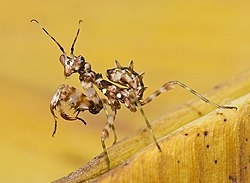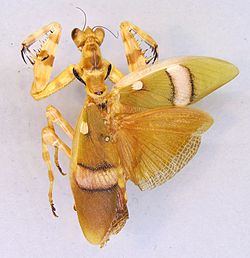| Species | Common names | Image | Distribution | Notes |
|---|
| Acromantis formosana | Taiwan flower mantis [8] |  | Taiwan | Nymphs are dark brown, flanged and spined, highly cryptic on dead leaves. Adults have green wings. |
| Blepharopsis mendica | Small devil's flower mantis [9]
Devil's flower mantis
Thistle mantis [10]
Egyptian flower mantis
Arab mantis [11] |  | North Africa, Canary Islands | Deimatic display with head and thorax rotated to one side. |
| Chloroharpax modesta | Nigerian flower mantis [12] |  | West Africa | Adult female has ocellated eyespots on wings. Aggressively hunts prey larger than itself. |
| Creobroter gemmatus and other species in genus Creobroter | Flower mantises [13] |  | South and Southeast Asia | Fly strongly on long wings. Eyespots on forewings, varying colours. Deimatic display of bright hindwings is flashed to startle predators. |
| Gongylus gongylodes | Wandering violin mantis
Ornate mantis
Indian rose mantis |  | South Asia | Up to 11 cm; males can fly. |
| Harpagomantis tricolor | African false flower mantis [15] |  | Southern Africa | A colourful ambush hunter that waits motionless on flowering plants. Length about 3 cm. |
| Hymenopus coronatus | Orchid mantis [16]
Walking flower mantis [17] |  | Southeast Asia | Hunts flies on "Straits Rhododendron", Melastoma polyanthum . |
| Idolomantis diabolica | [Giant] devil's flower mantis [18] [19] |  | Central and East Africa | Large insect, females as much as 13 cm. Brightly coloured deimatic display in red, white, blue, purple and black. |
| Helvia cardinalis (="Parymenopus davisoni") | Yellow flower mantis, [20]
Davison's mantis |  | Southeast Asia | A slender yellow mantis, the female with three dark spots on the wings |
| Pseudoharpax virescens | Gambian spotted-eye flower mantis [21] |  | East, Central, and West Africa | Adult female has eye spots on her abdomen. |
| Pseudocreobotra wahlbergii | Spiny flower mantis
Bulls-eye mantis
#9 mantis [22] |  | South and East Africa | Effective aggressive mimic of flowers, can handle prey much larger than itself, deimatic display with spread wings to show off "number 9" eyespots, variable coloration |
| Pseudocreobotra ocellata | Spiny flower mantis
Spiny flower praying mantis
African ocellated mantis [23] [24] |  | West, Central and Southern Africa | Like P. wahlbergii. |
| Theopropus elegans | Banded flower mantis
Asian boxer mantis [25] |  | Southeast Asia | White stripe on forewings. Colours can vary. |














